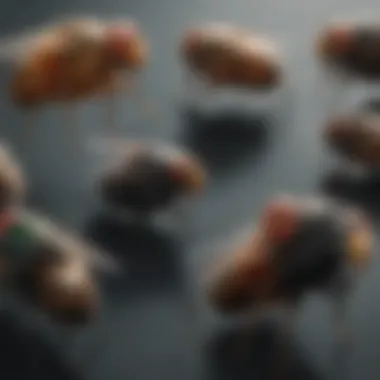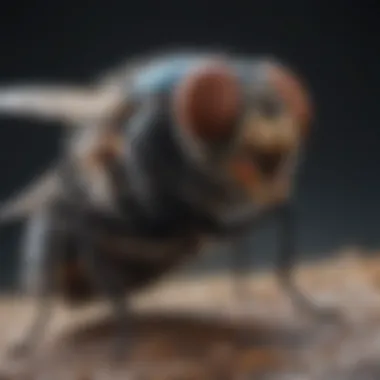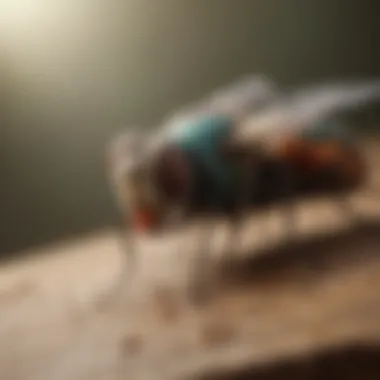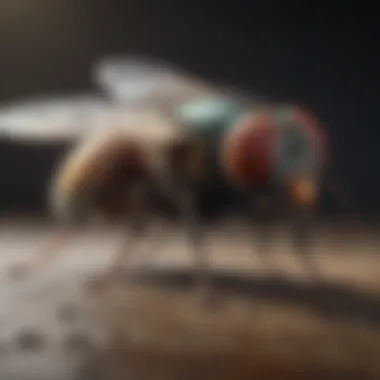Understanding Blow Fly Infestation: Biology, Risks, and Control


Intro
Pest Identification
Detailed Descriptions of Common Pests
Blow flies, scientifically known as Calliphoridae, are identifiable by their metallic color, which ranges from blue to green or black. Adult blow flies typically measure between 8 to 14 mm in length. They have large compound eyes, and the body is often covered in short hair. Notably, they are attracted to decaying organic matter, making them common near decomposing animal or vegetable remains.
Signs and Symptoms of Infestations
Identifying blow fly infestations can be straightforward if you know what to look for. Common indicators include:
- Visual Sightings: Adult blow flies flying around waste areas, garbage bins, or dead animals.
- Larval Presence: The presence of maggots, which are the larvae of blow flies, often found in rotting material.
- Unpleasant Odors: Strong, foul smells emanating from areas where blow flies are present.
"Early identification can prevent a minor issue from escalating into a major infestation."
Prevention Strategies
Home Maintenance Tips for Pest Prevention
Preventing blow fly infestations begins within the home. Consider the following practices:
- Regular Cleaning: Ensure that trash cans are emptied frequently and cleaned out to avoid attracting flies.
- Sealing Entry Points: Check for any cracks or openings where flies may enter and seal them effectively.
- Proper Food Storage: Keep food items sealed and stored in airtight containers. Dispose of any spoiled food.
Natural Deterrents and Barriers
There are several eco-friendly options that can deter blow flies from entering your home:
- Essential Oils: Oils such as eucalyptus, peppermint, and lemongrass can repel blow flies when used as a spray around entry points.
- Sticky Traps: Placing sticky traps near suspected entry points can help in catching and monitoring adult flies.
Treatment Options
Overview of Chemical vs. Natural Treatments
When it comes to treating infestations, homeowners have options. Chemical treatments, such as insecticides, can be effective but may pose risks to health and the environment. Natural treatments, on the other hand, tend to be safer but may require more time to yield results.
Step-by-Step Guides for DIY Treatments
For those opting for a more hands-on approach to controlling blow flies, here’s a simple guide:
- Identify the Source: Locate the area where flies are most active.
- Clean Thoroughly: Remove any decaying materials and clean the area to eliminate attractants.
- Use Natural Repellents: Apply a mixture of water and essential oils to deter remaining flies.
- Monitor with Traps: Set up traps to catch any stray adults that may still enter.
Prologue to Blow Flies
Understanding blow flies is critical for homeowners and pest control specialists alike. These insects play a significant role in various ecosystems, yet they can also pose substantial risks to human health when they infest living spaces. By examining the blow fly’s biology, behaviors, and preferences, we gain insights that can lead to more effective pest management strategies. Recognizing the impact these pests have on our environment helps in maintaining clean and safe spaces, especially in urban areas where infestations can occur.
Definition and Characteristics
Blow flies, belonging to the family Calliphoridae, are known for their metallic sheen, which can range from blue to green or black. These flies are typically larger than house flies, with adults measuring around 8 to 14 millimeters in length. They possess characteristic features such as large compound eyes and short, stubby antennae. The wings of blow flies are broad and have a unique structure that aids in their flying patterns.
These flies are particularly identified by their strong attraction to carrion or decaying organic matter, making them integral in the process of decomposition. Unlike other fly species, blow flies are capable of detecting decomposition from considerable distances due to their keen sense of smell. This adaptation not only facilitates their reproductive cycles but also highlights their role in nutrient recycling within ecosystems.
Ecological Role
In nature, blow flies serve as vital decomposers. They are often among the first insects to colonize dead animals or organic waste. This behavior fosters the breakdown of complex organic substances, enriching the soil and supporting new plant growth. Their presence indicates an active ecosystem, as they help ensure that nutrients are returned to the earth.
However, blow flies are also pests of significant concern. In urban settings, they can become problematic when they infest food sources or contaminate living spaces. Their life cycles involve rapid reproduction; a single female can lay hundreds of eggs, which can lead to quick infestations if not addressed.
Biology of Blow Flies


Understanding the biology of blow flies is crucial for grasping the broader implications of their presence in environments. Blow flies, belonging to the family Calliphoridae, exhibit a fascinating array of biological traits that contribute both to their ecological role and their potential to become pests. By examining their physical characteristics and life cycle stages, we can better understand how to manage and mitigate infestations effectively.
Physical Traits
Coloration
The coloration of blow flies serves a significant role in their identification as well as their behavior. Many species are recognized for their metallic sheen, often appearing in colors such as green, blue, or black. This distinctive characteristic not only distinguishes them from other insects but also provides them with some level of camouflage, especially around decomposing organic material. Understanding the coloration aids in quick identification, which is important in pest control strategies.
Size
Blow flies commonly vary in size, generally ranging from 7 to 14 millimeters in length. This size range makes them noticeable but not overwhelmingly large. Their size has implications for their ecological niche and their impact on waste management. A larger size can enhance visibility, making them easier to detect in areas of concern. However, their size also influences their mobility and the dispersion of their populations.
Wing Structure
The wing structure of blow flies is another vital characteristic. The wings are typically transparent with a specific shape that aids in their agility and flight patterns. Such a structure enables them to cover considerable distances in search of food sources. Understanding their wing anatomy is important when considering control measures, as it affects their ability to evade traps and other deterrents.
Life Cycle
Egg Stage
The life cycle of blow flies begins with the egg stage, which is critical in determining their population growth. Female blow flies lay numerous eggs on decaying organic material. This reproductive strategy ensures the hatching larvae have immediate access to food. Recognizing this stage is beneficial for implementing early intervention measures before infestations escalate.
Lava Stage
After the eggs hatch, they enter the larval stage, characterized by rapid growth. In this stage, larvae can consume a substantial amount of organic matter and can live in various conditions. Understanding the larval stage is critical for pest management since, at this point, they can cause significant damage to organic material, leading to health hazards and foul odors.
Pupal Stage
Following the larval stage, blow flies enter the pupal stage, during which they undergo metamorphosis. This stage is crucial because it marks a transition from immature to adult flies. Monitoring environments for pupa can reveal infestation levels and help pest control professionals determine the best course of action.
Adult Stage
Finally, the adult stage completes the life cycle of blow flies. Adults are social insects often found in clusters, which facilitates mating and further egg-laying. Understanding adult behavior, including their attraction to decaying substances, can inform effective management strategies. Identifying adults is essential in ascertaining the level of infestation in an area.
Causes of Blow Fly Infestation
Understanding the factors leading to blow fly infestations is essential in managing pest control effectively. These flies thrive in specific conditions, and this knowledge can significantly aid in preventing infestations. Recognizing the environmental factors and common attractants that contribute to blow fly presence can help homeowners take proactive actions.
Environmental Factors
The environment plays a crucial role in supporting blow fly populations. Specific elements such as temperature, humidity, and food sources can create favorable conditions for these pests.
Temperature
Temperature significantly impacts blow fly activity. These flies prefer warmer climates, typically thriving in temperatures ranging from 70 to 95 degrees Fahrenheit. In this article, we emphasize temperature as a key factor because it dictates the life cycle and behavior of blow flies. Warmer temperatures can accelerate their reproduction rate, allowing populations to grow quickly.
An increase in temperature can also lead to more frequent encounters between humans and this pest. As the temperature rises, it creates more opportunities for blow flies to seek food sources around homes. While managing temperature indoors isn't practical, understanding its influence helps in assessing potential risks during hot seasons.
Humidity
Humidity is another important factor. Blow flies are attracted to moist environments, which are crucial for their development. High humidity levels can facilitate faster larval growth and enhance the overall survival rate of blow flies.
In this article, we highlight humidity as a beneficial factor leading to infestation because it directly correlates with their breeding sites. Too much moisture can lead to more breeding opportunities, especially in outdoor spaces. However, excessive humidity might pose problems for homes by promoting mold growth alongside the possibility of blow flies.
Food Sources
Availability of food sources is fundamental in attracting blow flies. These pests are especially drawn to decaying organic matter, which serves as a breeding ground. Foods such as spoiled or rotting fruits, dead animals, and leftover garbage can all entice blow flies.
Identifying food sources is beneficial for understanding the dynamics of an infestation. Ensuring that potential food sources are properly disposed of can disrupt their life cycle. This article focuses on food sources because they are an element that can be managed effectively by homeowners. Reducing accessible food sources can help minimize infestations dramatically.


Common Attractants
In addition to environmental factors, certain attractants significantly contribute to the frequency of blow fly infestations. Common sources like decaying organic matter, animal waste, and garbage disposal areas are pivotal in understanding why blow flies invade specific locations.
Decaying Organic Matter
Decaying organic matter is perhaps the most significant attractant for blow flies. The smell of decomposing materials can be irresistible to adult flies seeking to lay their eggs.
In this article, decaying organic matter is considered crucial information for homeowners. It highlights the need for prompt waste management and composting practices. By recognizing this feature, homeowners can take measures to eliminate potential breeding sites, reducing the chance of infestations.
Animal Waste
Animal waste serves as another prime attractant for blow flies. Areas where pets defecate or where livestock are kept can quickly become hotspots for these pests. This topic is important because it affects households with pets or those near farms. Understanding this attractant can guide homeowners in maintaining cleanliness.
The unique feature of animal waste lies in its high nutritional value for larvae. This means that areas with animal waste not only attract adult blow flies but also provide an ideal environment for their young to thrive. Therefore, controlling animal waste can play a critical role in managing blow fly populations effectively.
Garbage Disposal Areas
Garbage disposal areas, especially poorly managed ones, are a magnet for blow flies. These spots typically contain a variety of organic waste that is prime for breeding. The relevance of garbage disposal in this context cannot be overstated.
Highlighting garbage disposal areas in this article aids homeowners who may overlook this source. Proper management of this area involves regular waste collection and keeping bins secured and clean. This unique feature presents an opportunity for homeowners to control access to potential breeding grounds, making good practices here essential in managing infestations.
Effective prevention strategies focus on reducing environmental factors and eliminating attractants.
Identifying Blow Fly Infestation
Identifying blow fly infestation is crucial for effective pest management. Recognizing the signs early can limit damage and potential health risks associated with these pests. Timely intervention based on proper identification helps homeowners and pest control professionals implement suitable control measures. This can also prevent the situation from escalating, which is especially important in urban settings where infestations can spread quickly.
Health Risks Associated with Blow Flies
The presence of blow flies in an environment goes beyond mere annoyance. Their role in organic decay and their attraction to waste can bring significant health risks. Understanding these risks is crucial for homeowners and pest control professionals alike.
Identifying the dangers posed by these insects not only informs better pest management practices but also reduces potential harm to human health.
Pathogen Transmission
Blow flies are known for their ability to carry pathogens. These insects frequent decaying organic matter, where they can pick up bacteria and other microorganisms. The common pathogens associated with blow flies include Salmonella and E. coli, both of which can cause severe illnesses. When blow flies land on food or surfaces within the home, they can transfer these pathogens, leading to foodborne diseases.
The high reproductive rate of blow flies means that a small infestation can quickly escalate, multiplying the probability of diseases spreading. This underscores the importance of responsive pest control measures when signs of infestation are noticed.
Allergic Reactions
Another important consideration is the potential for allergic reactions caused by blow flies. The insects can produce allergens in their saliva, feces, and decomposing bodies. Individuals who are sensitive may experience various symptoms ranging from mild irritation to severe reactions, including respiratory issues.
Ensuring cleanliness and proper sanitation can help minimize the presence of blow flies and therefore lessen the risk of allergic problems. Homeowners should verify that food is stored appropriately and waste is managed effectively to minimize attractants.
Proper hygiene is the first line of defense against blow fly infestations and the health risks they pose.
Preventing Blow Fly Infestation
Preventing blow fly infestations is crucial for maintaining a healthy living environment. These pests are not only a nuisance but also pose significant health risks. Effective prevention strategies can save homeowners from the stress and expenses involved in dealing with an infestation. By implementing good hygiene practices and environmental modifications, individuals can significantly reduce the likelihood of an infestation.
Hygiene Practices
Proper Waste Management
Proper waste management plays a pivotal role in preventing blow fly infestations. Ensuring that waste is disposed of correctly minimizes food sources. Blow flies are attracted to decaying organic matter, so regular disposal of trash is key. One key characteristic of proper waste management is regular collection and disposal, which curbs odors and prevents build-up. This method is a beneficial choice, as it not only deters flies but also keeps surroundings clean.
A unique feature of proper waste disposal is the use of sealed containers. These containers help contain odors and prevent access to pests. The advantages of using sealed bins include reduced risk of attracting blow flies and a more sanitary environment. On the downside, neglecting to maintain waste containers can lead to an attraction of these flies.
Eating Area Cleanliness
Eating area cleanliness is another important factor in preventing infestations. Keeping areas where food is prepared or consumed clean can reduce blow fly attractants. Frequent cleaning, especially after meals, is key to maintaining hygiene. This practice is popular among homeowners because it doesn't require much extra effort yet offers significant benefits.
A unique feature of food area cleanliness is the immediate clean-up after spills. This reduces the potential for food residues that can attract pests. The main advantage of this approach is that it minimizes food sources available for blow flies. However, it may require consistent effort, especially in households with children or pets.


Environmental Modifications
Removing Attractants
Removing attractants is essential for effective prevention of blow fly infestations. Actively eliminating sources of food and shelter helps deter these pests from lingering. This involves strategies such as cleaning up after pets and disposing of food scraps promptly. The key characteristic of this practice is proactivity; doing so keeps potential fly food sources limited. This is a popular choice for homeowners aiming to create a less conducive environment for pests.
A unique aspect of this method is utilizing compost bins that are properly sealed. This feature ensures that organic matter is stored without attracting pests. The advantages of this approach are numerous, such as promoting sustainability and reducing waste. However, if not maintained well, compost bins can also become a source of attraction.
Sealing Entry Points
Sealing entry points is a critical step in preventing blow fly infestations. Small gaps around doors, windows, and vents can act as gateways for flies. A key characteristic of this practice is the thorough inspection of potential entry areas. This strategy is beneficial as it creates a physical barrier against pests entering the home.
An effective method involves using weather stripping and caulking to cover gaps. This unique feature ensures that even the smallest openings are addressed, which is vital in prevention. The advantages of sealing entry points include enhanced energy efficiency and reduced pest invasions. Still, this process requires periodic checks to maintain structural integrity.
Effective prevention strategies can save homeowners from stress and expenses involved in dealing with an infestation.
By adopting these practices in daily routines and home maintenance schedules, individuals can significantly reduce the risks associated with blow fly infestations. It involves a commitment to hygiene, proactive adjustments, and safeguarding against environmental factors.
Managing Blow Fly Infestation
Managing blow fly infestation is crucial for maintaining a safe and hygienic environment, especially in residential areas. The presence of these flies can signal underlying sanitation issues. Effective management techniques not only target the flies themselves but also address the conditions that nurture their populations. Understanding the specifics of both do-it-yourself (DIY) methods and professional pest control options can empower homeowners and pest management professionals alike, leading to more effective strategies.
DIY Methods
Traps
Traps are a key component in managing blow fly populations. They function to capture adult flies, ultimately reducing their numbers in an area. The significant characteristic of traps is their ability to mitigate an infestation without the use of chemicals, making them a popular choice among environmentally-conscious homeowners. Often designed to be easy to use, common traps typically employ attractants to lure flies.
A unique feature of many traps is the use of sticky substances or attractants like sugar and vinegar, which effectively draw the flies in. While traps can significantly lower populations, they may not eliminate the problem entirely. Adequate placement is crucial; placing traps in the right locations can increase their effectiveness. However, traps require maintenance and timely disposal once filled.
Natural Repellents
Natural repellents serve as an alternative to harsh chemicals, appealing to those who prefer a more organic approach to pest control. The key characteristic of natural repellents is their use of non-toxic ingredients, often derived from essential oils. Popular options include peppermint and eucalyptus oils, which have been shown to deter blow flies effectively.
A unique feature of natural repellents is their dual function; not only do they repel flies, but they also often leave a pleasant scent in the area. However, while natural repellents can be effective in reducing the presence of flies, they may not offer a complete solution. Regular application is necessary, as their effectiveness can diminish quickly, especially in outdoor settings.
Professional Pest Control
Contacting Experts
Consulting pest control experts is a strategic move for anyone facing significant blow fly problems. These professionals bring specialized knowledge and tools to tackle infestations more effectively than DIY methods. One of the standout characteristics of contacting experts is the tailored approach they bring to each unique situation, assessing the specific needs of a property.
A unique aspect of engaging professionals is access to advanced techniques and products that are not available to the general public. However, this option can incur higher costs compared to DIY methods. The benefits usually justify the cost, particularly in eliminating large infestations or preventing future problems.
Integrated Pest Management Solutions
Integrated Pest Management (IPM) solutions provide a comprehensive approach to managing pests while considering the environment. The key characteristic of IPM is its balance of multiple strategies, including biological control, habitat modification, and chemical options as a last resort. This strategic method enhances effectiveness and sustainability in pest control.
The unique feature of IPM is its long-term perspective; it focuses on preventing infestations before they occur, instead of simply reacting to existing problems. IPM reduces reliance on chemicals, making it a beneficial practice for homeowners concerned about safety and environmental impact. However, implementing IPM may require more planning and ongoing effort compared to one-time treatments.
Culmination
Recap of Key Points
To briefly outline the main points discussed:
- Biology of Blow Flies: Their life cycle includes four stages: egg, larva, pupa, and adult. Each stage presents unique identification traits.
- Causes of Infestation: Environmental factors like temperature and food sources contribute heavily to their proliferation.
- Signs of Infestation: Indicators such as foul odors, presence of larvae, and adult flies are telltale signs.
- Health Risks: Blow flies pose risks through pathogen transmission and potential allergic reactions.
- Prevention and Control: Strategies include maintaining hygiene and environmental modifications to deter attraction.
- Management Options: Both DIY methods and professional pest control strategies can effectively manage infestations.
Future Considerations
As we think to the future, several aspects come to mind:
- Ongoing Research: There is a need for further research into environmentally friendly control methods. Sustainable practices are becoming increasingly important.
- Public Awareness: Increasing public awareness about sanitary practices can reduce overall infestations.
- Integrated Pest Management: Emphasizing a holistic approach that combines multiple strategies might be key to long-term solutions.
Understanding the dynamics of blow fly infestations can lead to healthier living environments and improved pest management practices.
By being proactive and informed, homeowners can ensure they are better prepared against the threat of blow flies in their homes.



